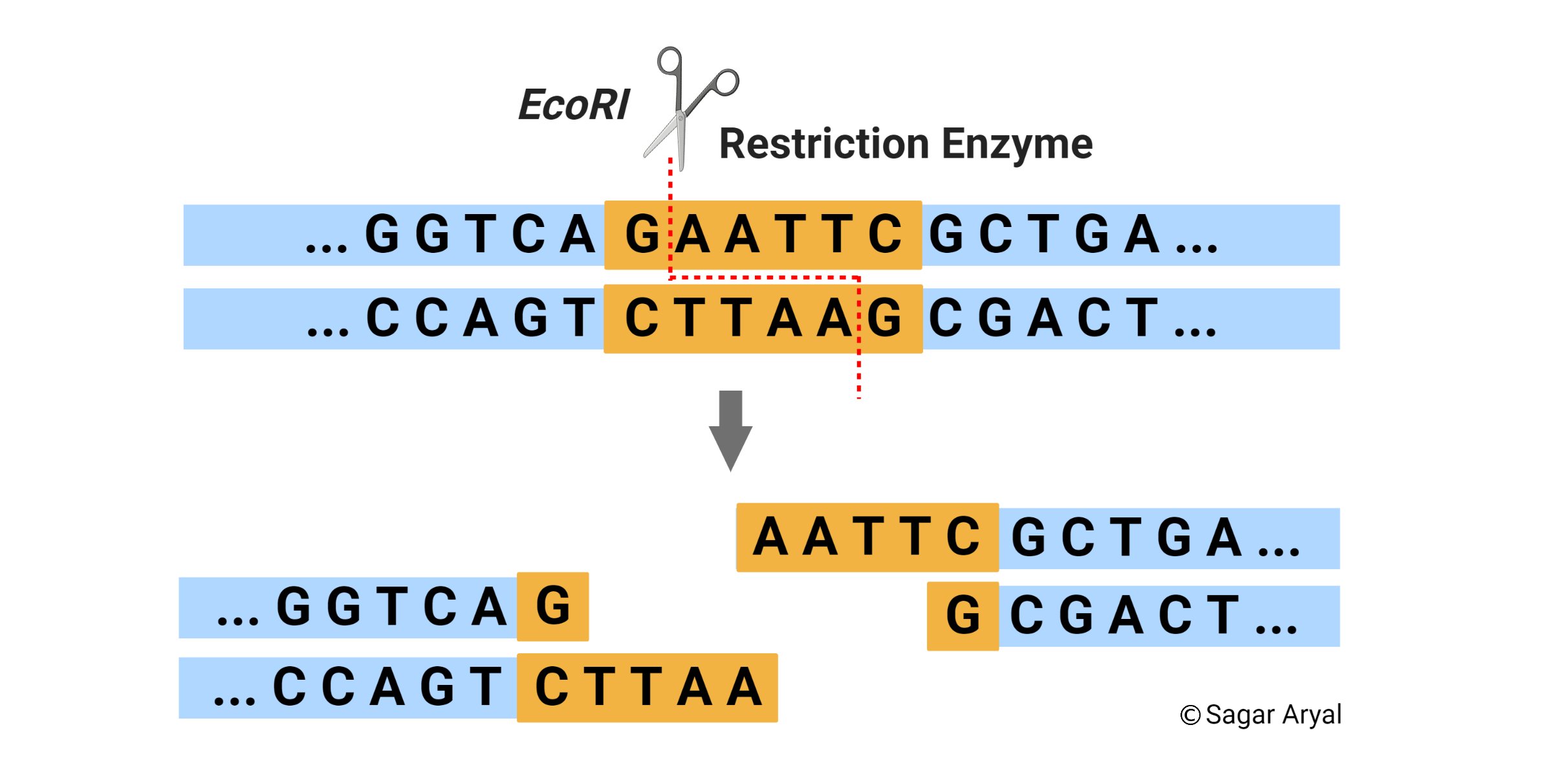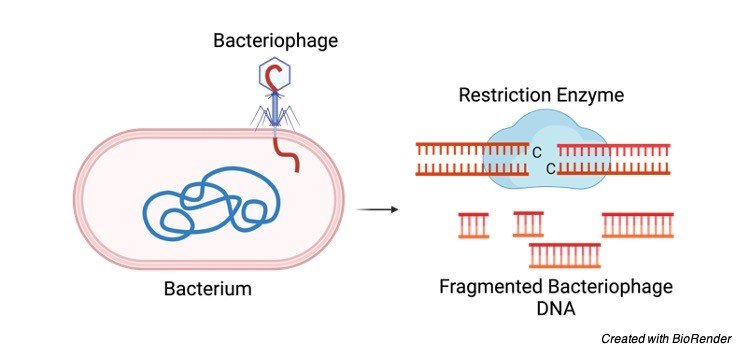Which of the Following Describe Restriciton Enzymes and Their Use
Forty years ago the scientists whose pioneering work had explored the activity and sequence specificity of these enzymes contributing to the definition of their enormous potential as tools. Other restriction enzymes like EcoRI cut through the DNA strands at.

Restriction Enzymes Powerpoint Slides
They allow researchers to obtain desired DNA fragments from genomic DNA.

. Which of the following sequences would a. Basic use of restriction enzymes. The bacteria add methyl groups to their own DNA to protect them from digestion.
These attack bacteria and try to infect them by inserting their DNA in the cells of the bacteria. SmaI is an example of a restriction enzyme that cuts straight through the DNA strands creating DNA fragments with a flat or blunt end. Restriction enzyme also called restriction endonuclease a protein produced by bacteria that cleaves DNA at specific sites along the molecule.
100 1 rating Answer. Each restriction endonuclease functions by inspecting the length of a DNA sequence. E All of the answer choices describe restriction enzymes.
They randomly cut DNA molecules to generate numerous fragments. When the DNA strands are cut there is a 5 and 3 prime side on each strand. There exist an enzyme called restriction enzyme that can identify a particular nucleotide sequence called restriction sites and perform cleaving operation.
In DNA fingerprinting restriction enzymes can be used to cut DNA to obtain the banding pattern of STR. The ends of the strand are either sticky or blunt so they can be attach to other DNA. Plasmid Restriction Enzyme Standard Curve.
Bacteria use restriction enzymes to protect themselves from a dangerous virus called a bacteriophage which translates to bacteria eater in literal terms. Restriction enzymes recognize and cut specific short sequences of DNA. Which statement best describes restriction enzymes.
2 Incubate at 72C for DNA synthesis. This process separates genetic material into smaller fragments which may contain gene s of interest. They are necessary for the polymerase chain reaction PCR to occur.
Mention two classes of restriction enzymes. C produce sticky ends that can bind foreign DNA. Restriction enzymes cut DNA molecules at a particular point by recognising a specific sequence.
Explain how the creation of sticky ends by restriction enzymes is useful in producing. Suggest their respective roles. Restriction enzymes cut DNA molecules at a particular point by recognising a specific sequence.
Once it finds its specific recognition sequence it will bind to the DNA and cut each of the two strands of the double helix at specific points in their sugar. Theyre found in bacteria which use the enzymes to digest invading DNA. 1 Incubate at 94C to denature DNA strands.
In the bacterial cell restriction enzymes cleave foreign DNA thus eliminating infecting organisms. Many restriction enzymes make staggered cuts at or near their recognition sites producing ends with a single-stranded overhang. What problem arises due to the presence of restriction endonucleases in bacteria.
The restriction enzyme recognises a unique sequence of nucleotides in the DNA strand which is usually between four to six base-pairs in length. Class I III and IV restriction enzymes is often ATP-depen-dent reviewed in Roberts et al. A- They allow the creation of recombinant molecules by cutting DNA molecules at particular sequences.
Restriction enzymes cut through both nucleotide strands breaking the DNA into fragments but they dont always do this in the same way. If two DNA molecules have matching ends they can be joined by the enzyme DNA ligase. They are important for cloning applications because they can be used to cut DNA at specific nucleotide sequences.
D facilitate inserting foreign DNA into vector DNA. Physical DNA mapping Since the first experiments by Danna and Nathans 1971 the major use of restriction enzymes was aimed at locating their cutting sites on selected DNA molecules. Describe the behavior and purpose of restriction enzymes.
Information on the size of the fragment can be achieved through the use of gel. Once it finds its specific recognition sequence it will bind to the DNA and cut each of the two strands of the double helix at specific points in their sugar. Restriction enzymes or to use their correct name restriction endonucleases are a type of enzyme which have the ability to cut molecules of DNA.
Each restriction endonuclease functions by inspecting the length of a DNA sequence. Restriction enzymes are also known as restriction endonuclease. They are often referred to as genetic scissors.
A restriction fragment is. B cut double-stranded DNA at specific sites. A restriction enzyme is used as an important tool for genetic engineering.
Describe how certain restriction enzymes generate DNA fragments with sticky ends while others generate blunt-ended fragments. Define the following terms. They typically recognize short palindromic DNA sequences They originate from bacteria Explanation.
Cut DNA into two strands so it can be copied. They can cut only circular plasmid DNA. B- They can be used to sequence DNA and RNA molecules c- They can be used to produce DNA molecules from RNA molecules and vice versa.
How is this problem resolved. Describe the function of restriction enzymes. How do they perform their function.
A restriction enzyme is a DNA-cutting enzyme that recognizes specific sites in DNA. Which of the following describe the significance of discovering restriction enzymes. Restriction enzymes can be isolated from bacterial cells and used in the laboratory to manipulate fragments of DNA such as those that.
Restriction enzymes A exist in bacteria to restrict the growth of viruses. Molecular biologists began using these enzymes along with DNA polymerase and DNA ligase an enzyme that sticks fragments. 3 Incubate at 60C for primer hybridization.
Restriction enzymes are a type of endonucleases that can be used to cut double-stranded DNA at specific regions. Which of the following places the steps in the PCR procedure in the correct order. Up to 10 cash back Restriction enzymes have been identified in the early 1950s of the past century and have quickly become key players in the molecular biology of DNA.
We review their content and use your feedback to keep the quality high.

Restriction Enzyme Restriction Endonuclease


No comments for "Which of the Following Describe Restriciton Enzymes and Their Use"
Post a Comment